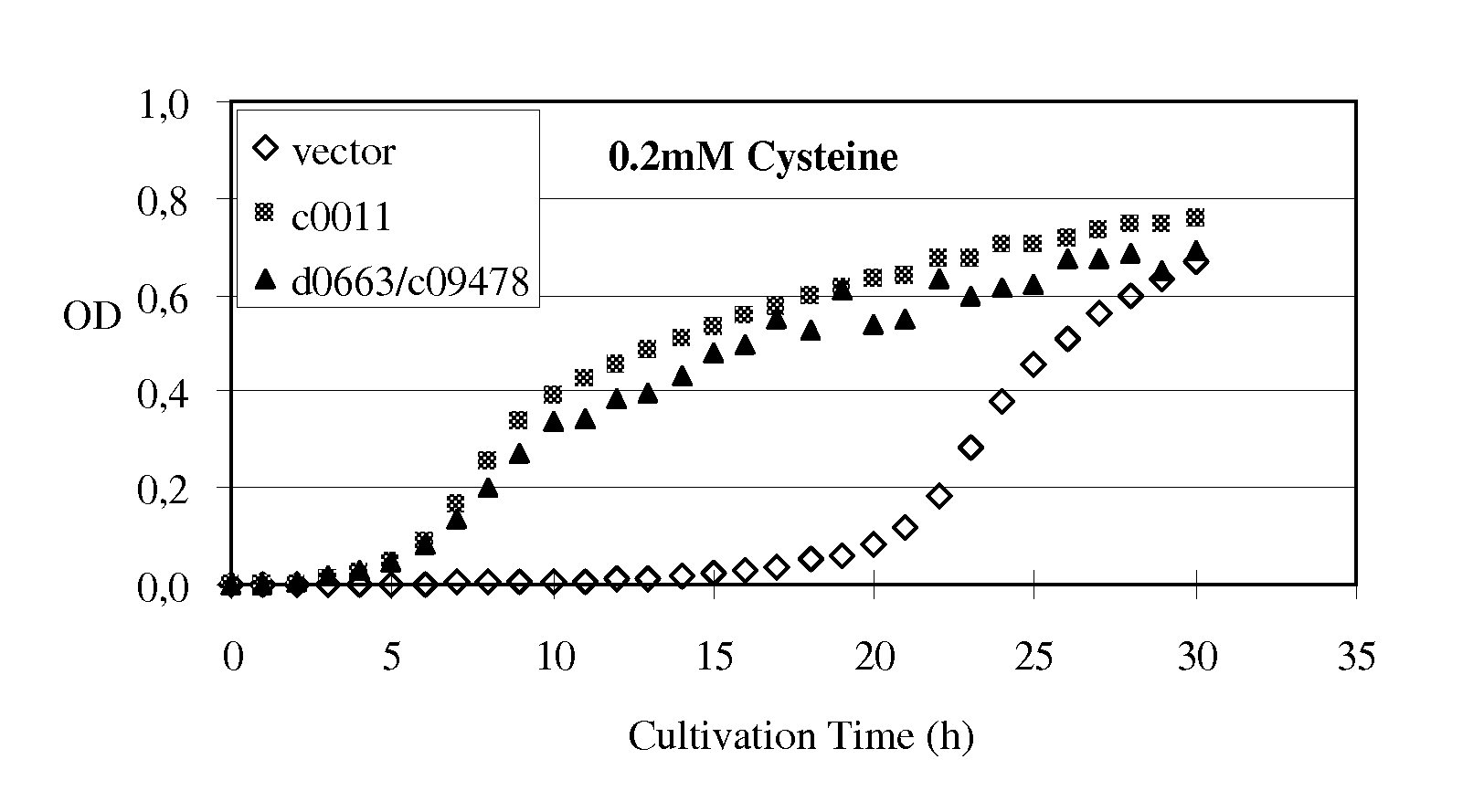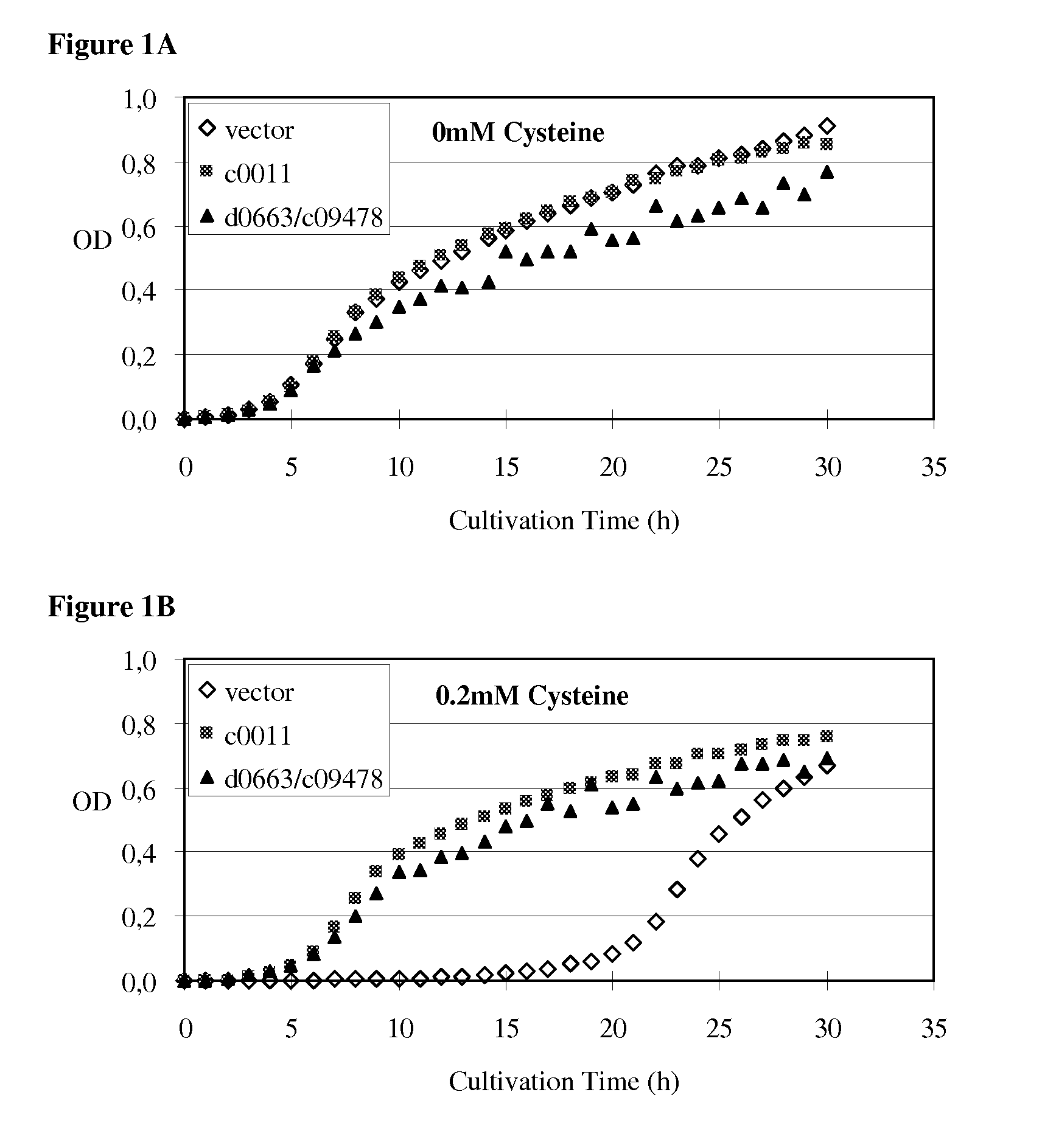Method for producing an L-amino acid using a bacterium of the Enterobacteriaceae family
a technology of enterobacteriaceae and l-amino acid, which is applied in the field of microorganism industry to achieve the effect of enhancing the productivity of l-amino acid-producing strains
- Summary
- Abstract
- Description
- Claims
- Application Information
AI Technical Summary
Benefits of technology
Problems solved by technology
Method used
Image
Examples
example 1
Over-Expression of Each of a Gene c0011 and a Gene Locus d0663-c09478
[0150]1-1. Cloning of c0011 Gene from P. ananatis SC17.
[0151]A DNA fragment containing approximate 300 nt upstream and 200 nt downstream of c00110RF was obtained by PCR from genomic DNA of P. ananatis SC17 using primers P1 (SEQ ID NO: 7) and P2 (SEQ ID NO: 8) with PrimeSTAR DNA polymerase (Takara Bio Inc.) (5 sec at 98° C., 10 sec at 55° C., 4 min at 72° C. for 30 cycles after 5 min at 94° C.).
[0152]The obtained 1.4 kb DNA fragment was cloned into a plasmid pSTV29 (Takara Bio Inc.) using BamHI sites designed at the 5′ end of each primer to obtain the plasmid pSTV-c0011 PF, in which c0011 gene was oriented in the same direction as the lacZ promoter located on pSTV29.
[0153]1-2. Cloning of d0663-c09478 Gene Locus from P. ananatis SC17.
[0154]A DNA fragment containing approximate 200 nt downstream of d0663 ORF through approximate 200 nt downstream of c09478 ORF was obtained by PCR from genomic DNA of P. ananatis SC17 us...
example 2
Effect of c0011 on the Fermentative Production of Cysteine
[0157]2-1. Construction of a Plasmid for Over-Expression of c0011.
[0158]Two types of expression plasmids pMIV-Pnlp0 and pNIV-Pnlp23 with different promoter strength were used for the over-expression of c0011. These plasmids contain the strong nlp0 promoter (or nlp23 promoter) and the rrnB terminator so that the target genes can be cloned between these structures to form an expression unit. The promoter “Pnlp0” (SEQ ID NO: 11) was derived from the promoter of the nlpD gene of E. coli K-12, “Pnlp23” (SEQ ID NO: 12) and “Pnlp8” (SEQ ID NO: 13) (see below for further details) are the variants with different strengths of the promoter activity (U.S. Patent Application Publication No. 2010 / 209977). The overall scheme of the construct of these expression plasmids is described below (see Reference Example 1) as a construct of plasmid pMIV-Pnlp0-YeaS3 where yeaS gene from E. coli K-12 is cloned between nlp0 promoter and rrnB terminator...
example 3
Effect of c0011 on the Fermentative Production of Amino Acids
[0188]3-1. Effect of c0011 on the Production of Amino Acids in E. coli.
[0189]To test the effect of c0011 over-expression on the production of amino acids other than cysteine, pMIV-Pnlp0-c0011 and pMIV-5JS (control) were introduced into MG1655. Resulting strains were subjected to the production tests comparing capacity of the fermentative production of amino acids. The productive cultivation was executed as described in the experiment for cysteine production with E. coli, except cultivation time was 19-24.5 hrs. For maintenance of the plasmids, 25 mg / L of chloramphenicol was supplemented into the medium during the course of cultivation. Quantitative analysis of produced L-amino acids in the culture medium was performed using Amino Acid Analyzer L-8900 (HITACHI). Amounts of amino acids with corresponding values of standard deviation from data for each strain (four independent test tube fermentations) are shown in Table 3. A...
PUM
| Property | Measurement | Unit |
|---|---|---|
| temperature | aaaaa | aaaaa |
| internal diameter | aaaaa | aaaaa |
| internal diameter | aaaaa | aaaaa |
Abstract
Description
Claims
Application Information
 Login to View More
Login to View More - R&D
- Intellectual Property
- Life Sciences
- Materials
- Tech Scout
- Unparalleled Data Quality
- Higher Quality Content
- 60% Fewer Hallucinations
Browse by: Latest US Patents, China's latest patents, Technical Efficacy Thesaurus, Application Domain, Technology Topic, Popular Technical Reports.
© 2025 PatSnap. All rights reserved.Legal|Privacy policy|Modern Slavery Act Transparency Statement|Sitemap|About US| Contact US: help@patsnap.com


